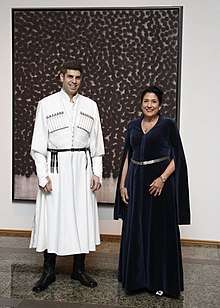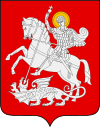Chokha
A chokha (Georgian: ჩოხა chokha or ტალავარი t'alavari; Abkhazian: акәымжәы, romanized: akʷymzhʷy; Adyghe: цые, romanized: tsiya; Persian: چوقا, romanized: chughā; Armenian: չուխայ, romanized: choukha(y); Azerbaijani: çuxa;[1] Chechen: чокхиб, romanized: ҫoqib; Kabardian: цей, romanized: tsei; Lezgian: чуха, romanized: chukha; Ossetian: цухъхъа, romanized: cuqqa; Russian: черкеска, romanized: cherkeska; Ukrainian: черкеска, romanized: cherkeska) is a woolen coat with a high neck that is part of the traditional male dress of the peoples of the Caucasus.[2]
.jpg)
| Part of a series on |
| Georgians ქართველები |
|---|
| Nation |
| Georgia |
| Ancient Kartvelian people |
|
| Subgroups |
| Culture |
|
| Languages |
| Religion |
| Symbols |
|
| History of Georgia |
History and revival

The chokha has been in wide use among Georgians[3] from the 9th century until the 1920s.[4] It is still used in Georgia as a symbol of national pride, and is frequently worn by Georgian men at weddings and official functions.[5] Worn by Georgians for more than a thousand years, the high-necked wool coat was rarely seen during Soviet rule, but now, for many, it symbolizes pride in the country's past and resistance to its occupation.[6]
Former Georgian President Mikheil Saakashvili ordered high-ranking Georgian officials working abroad to present themselves in national costumes, including the chokha, at official meetings.[7]
Types

There are four types of chokha: the Kartl-Kakheti chokha (Kartli and Kakheti are eastern Georgian provinces), the Khevsur chokha (mainly in the Mtskheta-Mtianeti province of Georgia), the Adjarian chokha (mainly found in western Georgian provinces such as Adjara and Guria, previously also in Lazona), and the general Caucasian chokha.
The Caucasian chokha originated in the Caucasus[8] in the mountainous areas of Georgia. The word chokha entered the Georgian language from Persian. Originally, in Georgia, the garment was referred to as talavari, but later on, after the Persian invasions, Persians started to call Georgian national dress chokha (meaning 'outfit made of fabric'). Russians and Ukrainians called it a cherkeska (meaning 'of/from Circassia'), and the Kuban Cossacks adopted it as part of their costume. In Circassian languages, the chokha is known as shwakh-tsia which means 'covers the horseman', or simply tsia which means 'from fabric' and fasha which means 'fits you'.
In Georgia, special decorations, in addition to Talavari/Chokha, were adopted by the Order of Chokhosani, who represented an elite cadre of generals, war heroes and famous poets.
The chokha is sewn from thick fabric and flares out at the bottom. In some parts of the Caucasus there are also female chokhas.
In the late 19th century and early 20th century there were three types of chokhas: the Khevsur chokha, the Kartl-Kakheti chokha and general Caucasian chokha.
Khevsurian chokha

The Khevsur chokha was worn in the Khevsureti province of Georgia in the Greater Caucasus mountains. The Khevsur chokha is considered to be the closest to the medieval version of the chokha. It is mostly short, with trapezoid shapes. The front side of the chokha has rich decorations and slits on the sides, which extend to the waist. The Khevsur chokha has rich decorations made up of crosses and icons.
Kartli-Kakheti chokha

The Kartli-Kakheti chokha is longer than the Khevsur chokha and has triangle-like shapes on the chest, exposing the inner cloth called arkhalukhi. It tends to have gazyrs (locally called masri) on both sides of the chest-spaces. The skirt usually has slits on the sides. People wear them without belts. The Kartli-Kakheti chokha has long sleeves and is usually black, dark red or blue.
This is the most popular chokha up to date, often seen in official meeting and musical performance.
General Caucasian chokha
The general Caucasian chokha shares similarities with the Kartl-Kakheti version. In most cases, different decorations fill the bullet spaces. This type of chokha has black leather belts decorated with silver pieces. It is usually a longer version of the Kartl-kakheti Chokha.[3]
The general Caucasian chokha is usually made of black, grey, white, blue, red or brown fabric. Among Azeris, it is considered part of the traditional outfit for the performers of mugham, an Azeri folk music genre. Traditionally a person's age determines the colour of their chokha.
Generally, the chokha outfit includes a khanjali dagger, an akhalukhi shirt worn under the chokha, masrebi (gazyrs, bullet/charge holders), and a kabalakhi (bashlyk, a hood, separate from the robe) or nabdis kudi (papakha, a tall fur hat).
References
| Wikimedia Commons has media related to Chokha. |
- Азербайджанская национальная одежда [Azerbaijani national garments] (in Russian). Azclub.ru. Archived from the original on 2007-03-21. Retrieved 16 April 2013.
- McGuinness, Damien (10 July 2011). "Close-Up: Why Georgia's national costume is back in vogue". BBC.com. Retrieved 15 April 2018.
- Strelkova, Ruso (31 August 2007). "To Wear or not to Wear (a Chokha)? That is the Question". Georgia Today. No. 372.
- Abashidze, Irakli. Ed. Georgian Encyclopedia. Vol. IX. Tbilisi, Georgia: 1985.
- "Georgia: Love Your Country, Love Your Chokha". EurasiaNet.org. 2011-02-20. Retrieved 2013-04-16.
- "BBC News - Close-Up: Why Georgia's national costume is back in vogue". Bbc.co.uk. 2011-07-10. Retrieved 2013-04-16.
- Emkhvari, Elias (25 April 2008). "Chokha". georgiandaily.com. Archived from the original on 13 August 2008. Retrieved 16 April 2013.
- Abashidze, Irakli. Ed. Georgian Encyclopedia. Vol. IX. Tbilisi, Georgia: 1985
